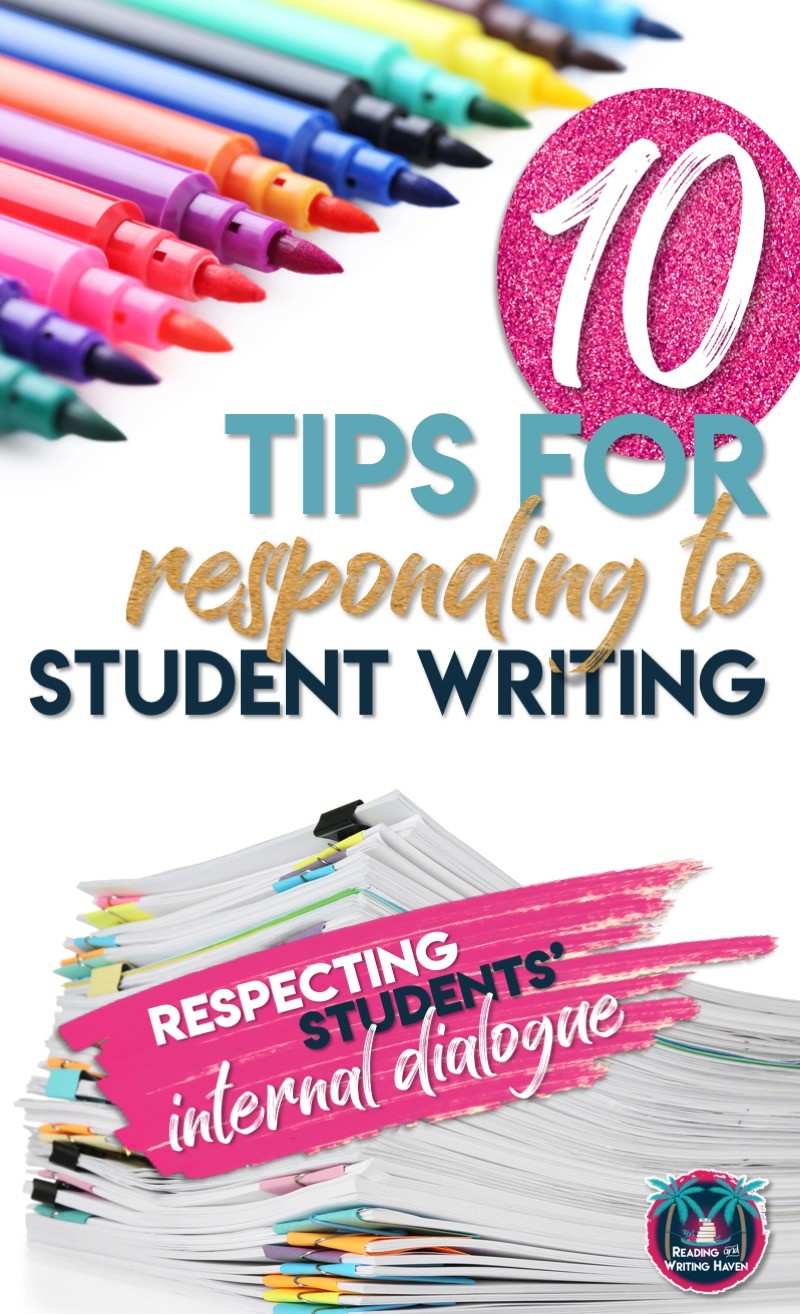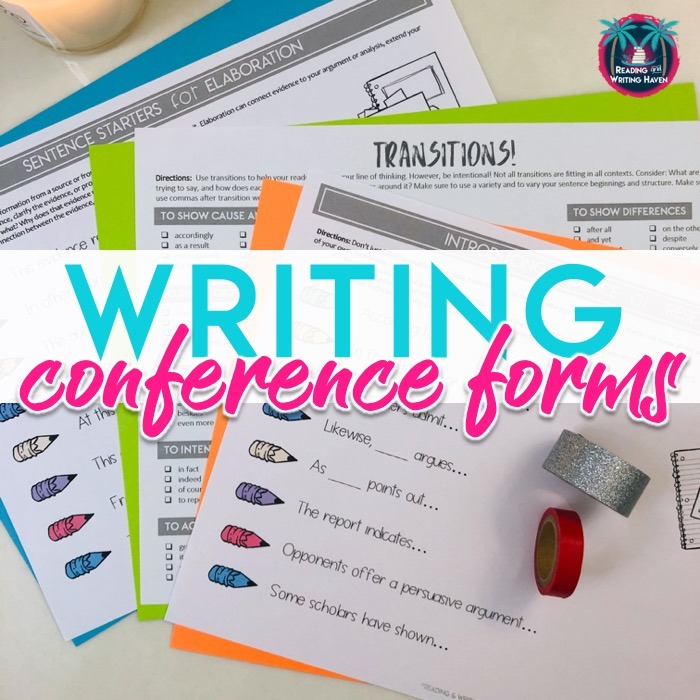How to Respond to Student Writing: 10 Ways to Give Feedback that Sticks
Have you ever had the experience of a student crying, arguing, or yelling after handing back a graded essay? Have you personally ever felt wronged by a teacher or college professor whose feedback on an essay left you feeling one inch tall? Responding to writing is challenging because…writing is vulnerable. People have an emotional connection to the words they put on paper. If you’re wondering how to give feedback on student writing in an effective manner, this post is for you.
The way teachers provide feedback on students’ writing directly impacts their internal dialogue and self-perceptions. None of us approach grading essays with the intention of making a student feel bad, but we always know when it has inadvertently happened.
The problem comes in when English teachers have 150 papers to grade at a time. It can be easy to fall into the trap of commenting quickly to get through the massive stack faster – understandable on many levels. What that means, though, is that we might not be putting the amount of thought into our feedback that we need to in terms of being sensitive to how students will perceive it.
So, what can we do? If you’ve landed on this post because you’re wondering how to give feedback on student writing, here are ten tips that could provide some fresh insight.
HOW TO GIVE FEEDBACK ON STUDENT WRITING
1. NARROW THE FOCUS
When responding to writing, we need to think about what we really want our students to know. We can’t comment on everything because students won’t learn #allthethings like we hope they will. Instead, we can provide fewer comments that are meaningful suggestions worded in a way that are sensitive to students’ perceptions.
For example, if a student’s essay is full of spelling errors, it’s not necessary to circle every word (although it may be tempting to do so). Why not just write, “Please check spelling throughout the essay” or “Please ask a parent help you spell check”? These comments are more positive and seem like less of a Sisyphean task.
2. ASK QUESTIONS INSTEAD OF MAKING STATEMENTS
Research shows that asking questions is more beneficial to learning than making statements. Questions push people to figure out answers on their own. In terms of wanting to influence students’ self talk in a positive way, consider the following.
Maybe you notice a student’s essay is wrought with run-ons. Would it be more beneficial to…
- State: “There are run-ons in every paragraph. Proofread more carefully.” OR….
- Ask: “Where might you insert end marks to help the audience follow your line of thinking more easily? Please review the notes on sentence errors and then make some revisions.”
3. CONFER WITH STUDENTS
It’s a lot easier to word suggestions in a positive manner if you are speaking with the student. In writing, it’s more difficult to infer tone, and it’s easier to write something that is brash than it is to speak it. Talking with students is one way to get to know them better as writers and as people.
Students need to feel a genuine relationship with their teacher in order to really be vulnerable and accept suggestions for improvement. Plus, conferring with students means we spend less time grading a mountain of papers. During conferring, we can word suggestions kindly to build students’ optimistic self-talk.
Not sure how to get organized? These writing conference forms can help.
4. USE A ONE-TO-ONE RATIO
Students will be more receptive to constructive feedback when it’s balanced with praise. Point out students’ strengths. Tell them what they did well. If you can’t find enough strengths in their writing, it’s probably a good idea just to help them develop one goal to work on for improvement. Anything else would be overwhelming…and it might make them feel incapable.
Plus, how many things can a student work on improving at the same time and truly master? A one-to-one ratio is a good goal to begin with if you’re not used to balancing feedback. Begin with the positive.
5. KEEP FEEDBACK TIMELY
When talking about how to give feedback on student writing, the answer is often in the timing. It can be difficult to provide feedback quickly after students submit an essay. However, when we allow too much time to pass, the feedback is no longer relevant to students. That’s a problem when we want our feedback to build confidence while also encouraging students to want to grow.
Helping students develop their writing skills requires a trusting relationship between teacher and pupil. If a student can’t depend on the teacher to return an essay within a reasonable amount of time, why would they trust us when we offer suggestions for improvement? What are we really saying when we don’t hand back feedback for two months after students submit an essay? What message does that convey?

6. JUST READ
The answer to the question of how to respond to student writing may be much more simple than it seems. The first time you look at a student’s essay, just read it. Take time to reflect on what you read before making any comments. This strategy will help you to write only the things that matter most and reduce time nit-picking every error.
Sometimes when responding to writing, our impulse is to point out every imperfection, but that doesn’t help the student or us as teachers. Just put away the pen for the first reading, and then balance positive and constructive feedback as you note the most important goals for each student.
7. ASK STUDENTS TO REFLECT
One important step in helping students improve their internal dialogue is allowing them to find their own mistakes. It’s true, students won’t find everything you will. But, when we provide them with a rubric we have carefully explained and referenced in advance, they should be able to pinpoint areas where they can grow.
Understanding how students view their writing will help us in two ways:
- We will be aware of what students think their strengths and weaknesses are. In this way, if they think their ideas are excellent, we know that we need to have a conversation with them about how content can be improved rather than writing feedback in the margins and giving them an “unsatisfactory” rating for that component.
- It prepares students to accept help. If they know their writing isn’t perfect, they will be less likely to negatively internalize suggestions for improvement.
8. BE SPECIFIC
It’s easy to rush through grading papers and leave vague comments like “awkward” or “confusing.” Yet, those comments don’t help students, and they typically are not internalized positively. A more helpful approach would be to leave kind, specific suggestions. For example, “Can you clarify this argument? I’m not sure what you mean here” or “Is the hotdog driving the car? Try rewording the sentence to clarify.”
Even when we are leaving good feedback, it helps to be specific. Rather than, “good” or “love this!” try writing, “This sentence really emphasizes the importance of the research” or “This transition is so helpful for readers to follow your line of thinking.”
9. CLARIFY THE AUDIENCE’S VIEW
Instead of pointing out what the writer did wrong, focus on what might confuse readers. For instance, will the audience be confused about how the hook relates to the thesis? You could ask, “What is the connection between the hook and the thesis? Can you help readers understand how they relate in the bridge?”
Another example might be if a student only cites direct quotes in the essay and does not paraphrase research. You could write, “How many of the sentences in this paragraph are in your own wording? How might you revise so that the audience will be able to hear your voice coming through?”
Focusing on what the readers need instead of what the writer did wrong is another way we can be sensitive to students’ internal dialogue.
10. HELP STUDENTS UNDERSTAND THEMSELVES
What we stress in our feedback shapes how students view their writing abilities. It’s important that our feedback leads students to a point where they can see their own strengths and weaknesses. Pointing out patterns can be useful because students are not usually able to observe these patterns about themselves.
To illustrate, maybe a student is a talented writer, but he or she is consistently verbose. We can show students these areas for growth through our feedback.
I love how you take time to select words that are meaningful and precise. I can tell you put a lot of time and effort into writing sentences that are mature. I’m proud of you! Here is one area for growth I’d like you to consider: How can you maintain your personal style and your impressive word choice while also being more concise so that readers are can follow along easier?
Alternatively, give students your feedback, but don’t attach it to a grade. Allow them to let the feedback (using the tips above) sink in and reflect on their own areas for growth according to the rubric.
Responding to writing in a way that improves students’ internal dialogue and respects their readiness levels is hard. The best approach is for us to put ourselves in our students’ shoes. What would we want or not want a teacher to tell us?
Still pondering how to give feedback on student writing? Lauralee from Language Arts Classroom has some ideas to share.
READ NEXT:
RELATED RESOURCE:
Make feedback as meaningful as possible by conferring with student writers. Writing conferences help us to build confidence, establish relationships, and differentiate writing goals for all students. Use these writing forms to get started!
